  |


That first simulator cost $150,000 and we were sure it would be worth every penny to us. Trouble was, FlightSafety didn't have that kind of money, and the banks weren't at all interested in lending it to us. So we had to find it somewhere else. As it turned out, some of our best customers not only agreed with the value of simulator training but also backed their convictions with hard cash. A nucleus of flight departments, including those at Eastman Kodak, National Dairies, Coca-Cola, Gulf Oil and Olin Mathieson, agreed to advance us a total of nearly $70,000 to guarantee training for their pilots within five years of simulator delivery. With those checks in hand, we got our simulator.Although it was primitive technology by today's standards, that second-generation Link helped advance FlightSafety to a new level of service. And customers began to respond. We got our Translator in 1955. FlightSafety had been struggling for four years, but with that acquisition, it looked like we were going to succeed.
I've always believed that if you're doing something that matters, you should do it right. So when FlightSafety began, I sought out the best legal counsel I knew - Leslie Arps, an attorney who handled some of Pan Am's affairs. And once FlightSafety survived its infancy and looked like it might someday prosper, I called in Price Waterhouse to audit our books. Doing things right at the outset has staying power.
Flight Safety International, Inc.
All rights reserved



